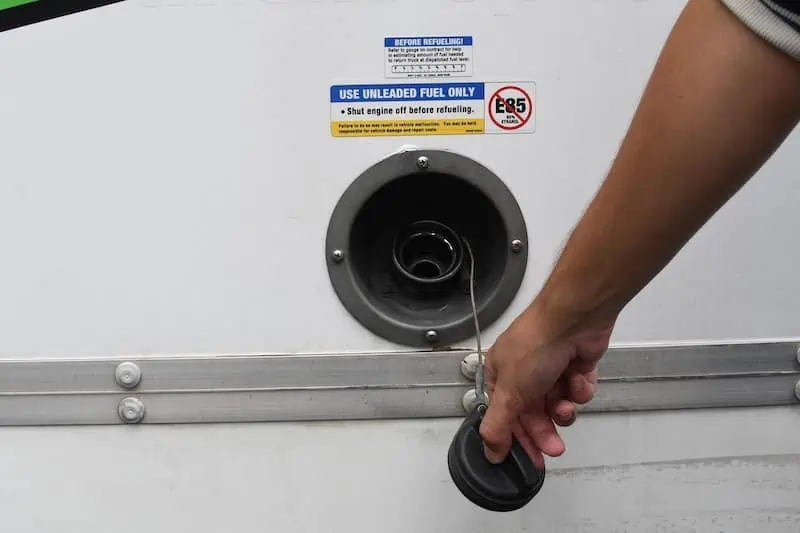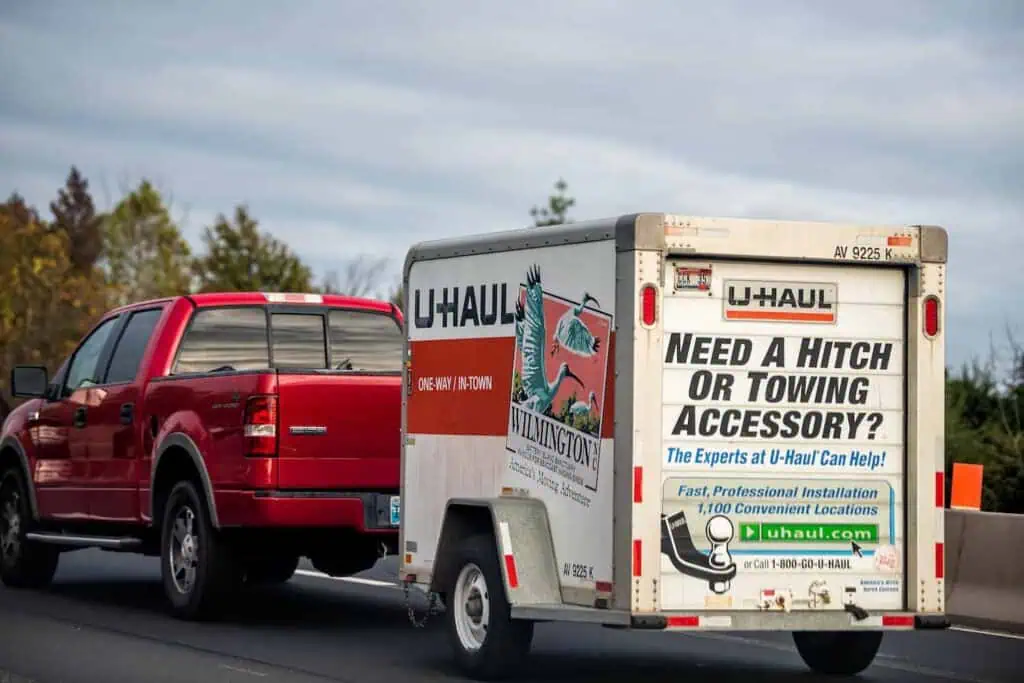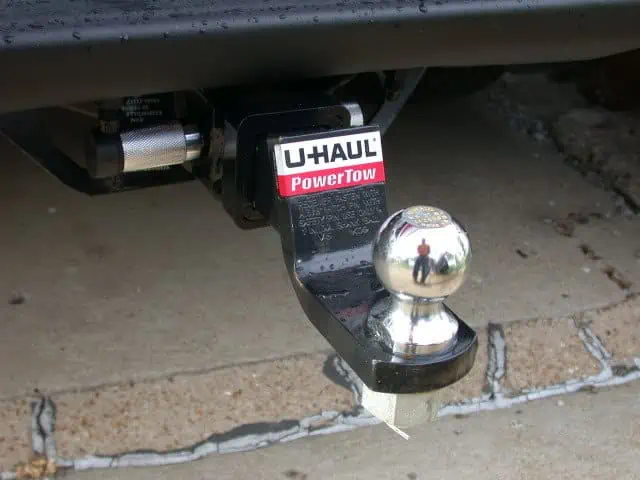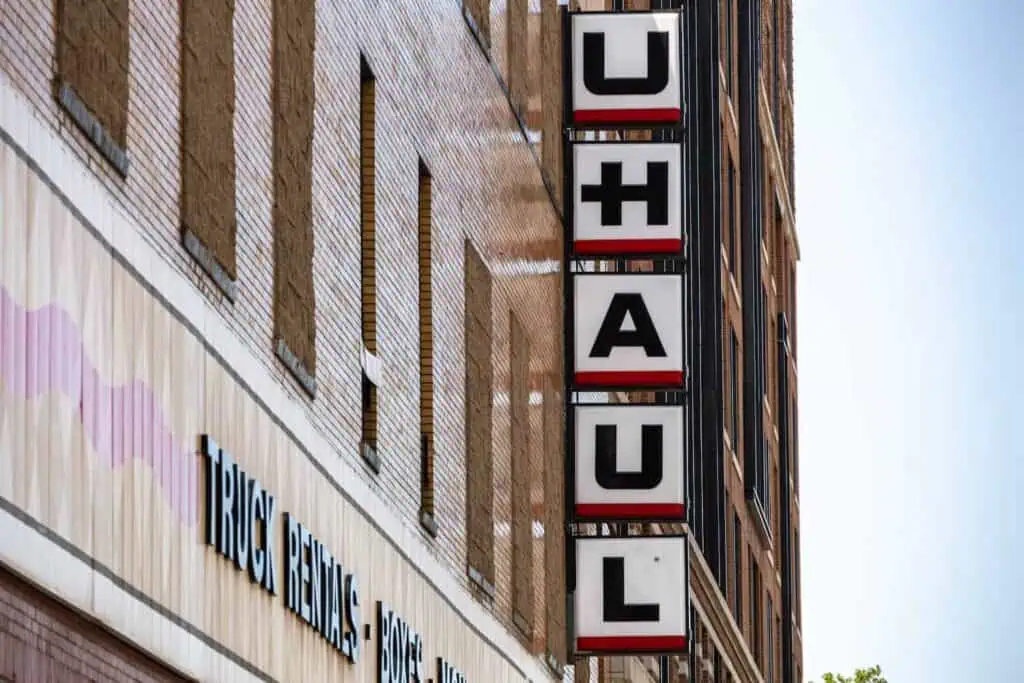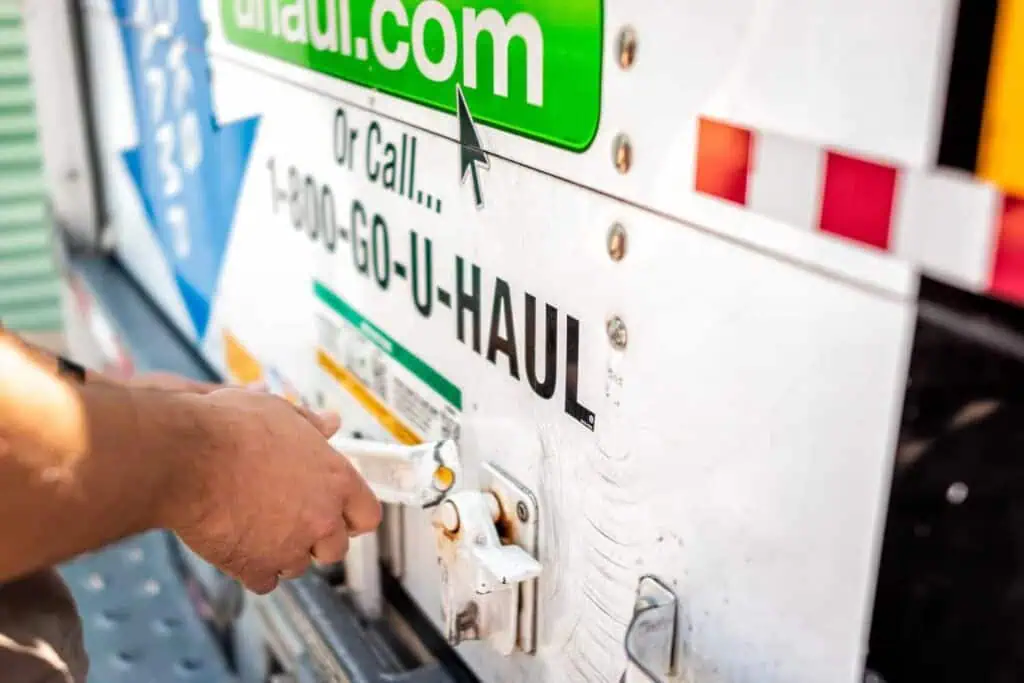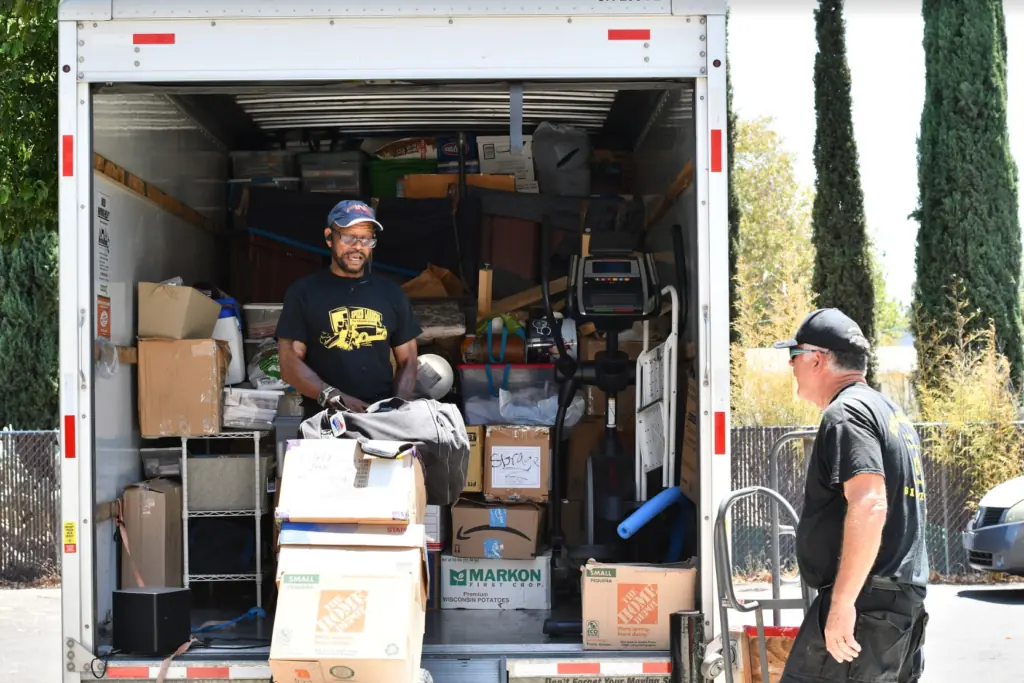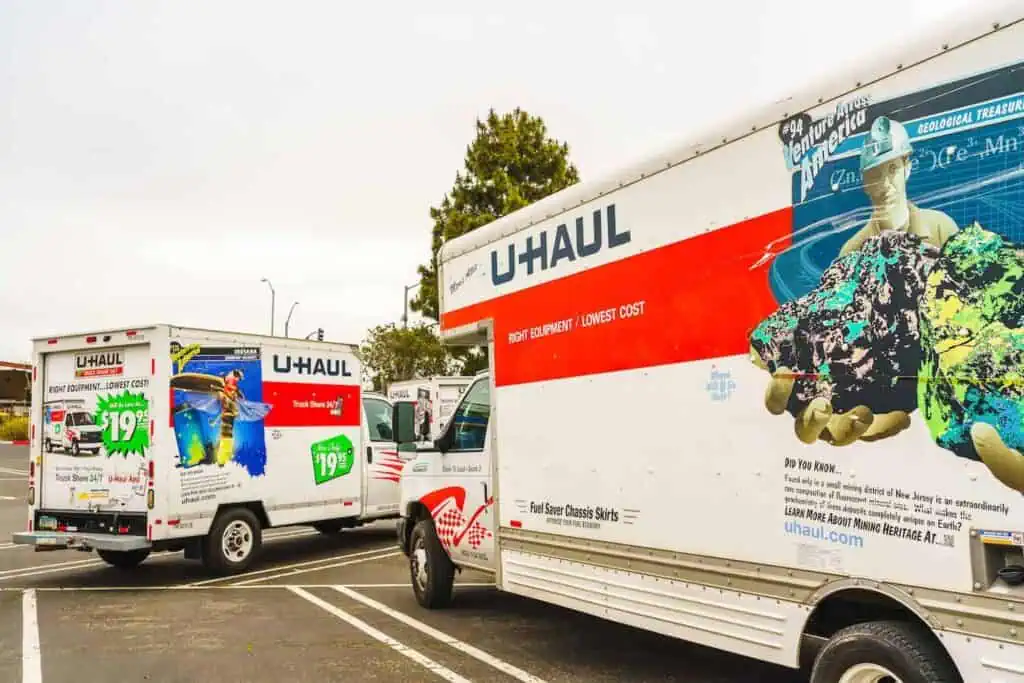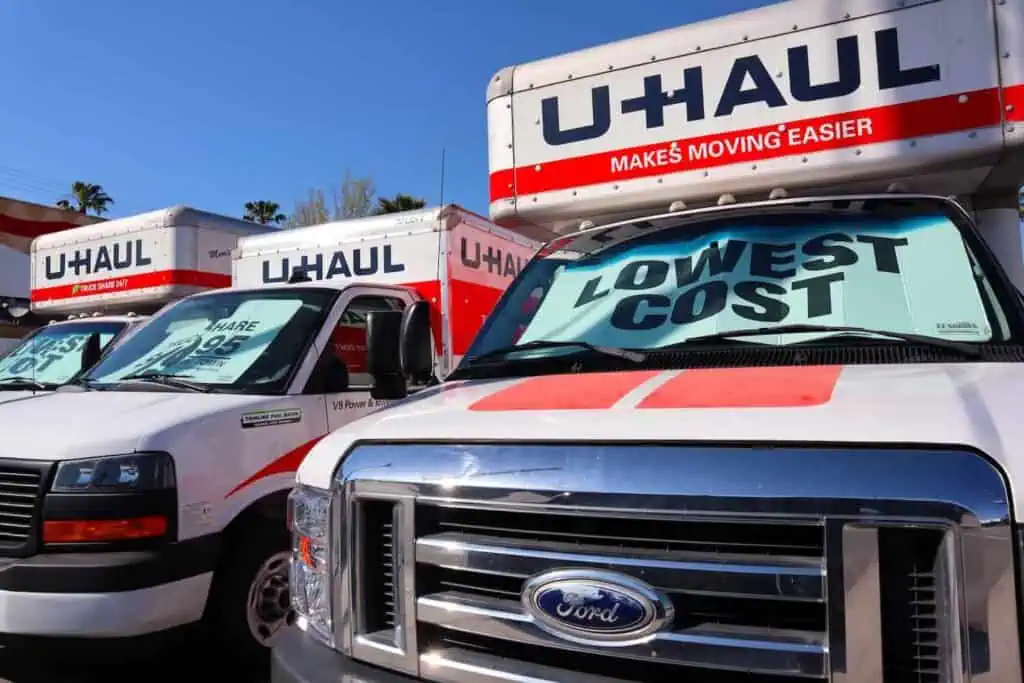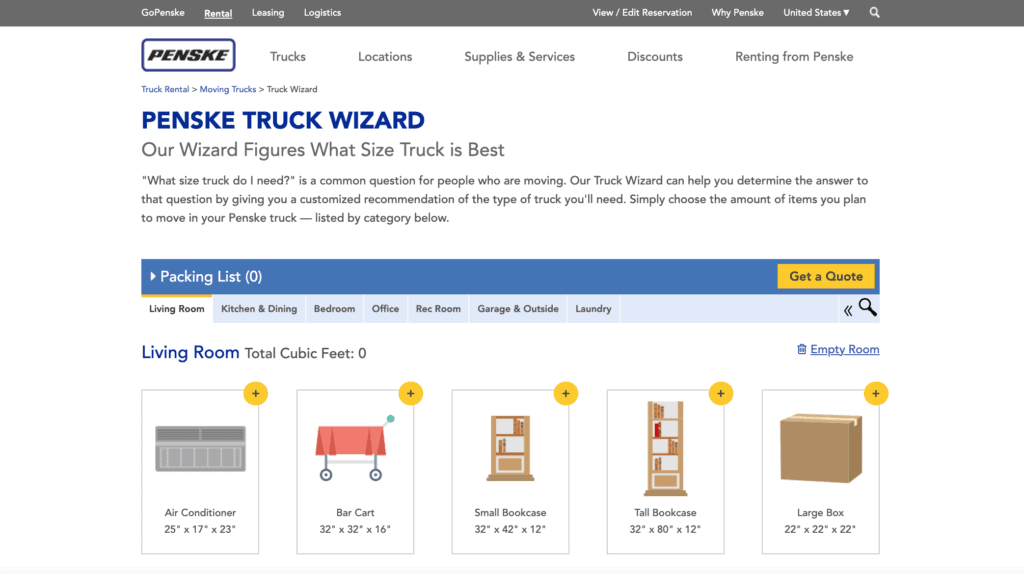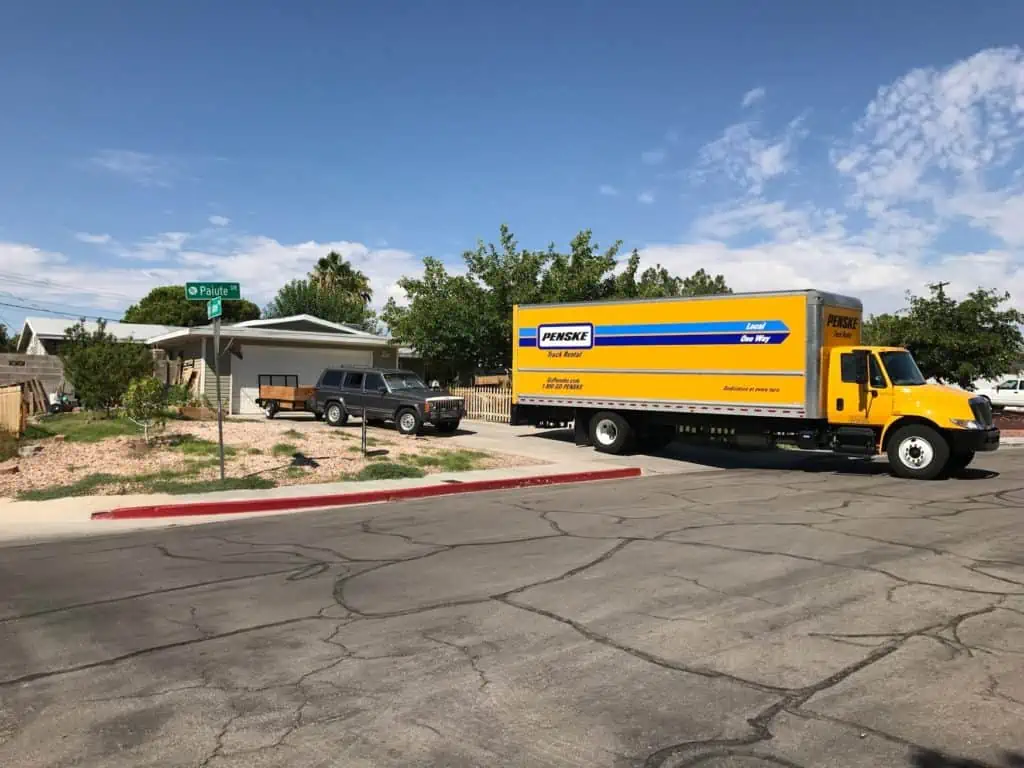Pricing Updated and Confirmed as of May 2025
We’ve all seen it: $19.95 per day. That attractively low cost advertised on the side of seemingly every U-Haul truck and van across the country. And that price looks nice.
A little too nice, you might say. And indeed, you’d be right. Just like renting a truck is only one small part of your move, that low $19.95 U-Haul cost is likely to end up being just a fraction of your final bill. We know, because we set out to rent a U-Haul with one question in mind: How much does a U-Haul really cost?
Keep reading for a transparent, in-depth look at our first-hand research into U-Haul’s real rental rates.
U-Haul Rental Rates: Local/In-Town Moves
The table below compares the four U-Haul truck sizes side by side in a simple, no-frills, local move. Basic insurance coverage was purchased, and we drove 50 miles. That’s it.
As you can see, while the base rate for each truck ranges between $20 and $50 per day, the actual daily rental cost is over $100 in every case.
How Much Is a U-Haul Per Day?
| U-Haul Truck Size | Base Daily Rate | Mileage Fees ($1.19) |
Miles | Basic Coverage | Add’l Fees and Taxes | Gas ($3.12) |
Total Cost Per day |
| 10-ft Truck | $19.95 | $59.50 | 50 | $15 | $7.83 | $12.98 | $115.26 |
| 15-ft Truck | $29.95 | $59.50 | 50 | $15 | $8.53 | $15.60 | $128.58 |
| 20-ft Truck | $39.95 | $59.50 | 50 | $15 | $9.23 | $15.60 | $139.28 |
| 26-ft Truck | $49.95 | $59.50 | 50 | $15 | $9.93 | $15.60 | $149.98 |
Clearly, there’s much more to U-Haul’s pricing than the $19.95 per day base rate. In this article, we’ll be covering the ins and outs of U-Haul pricing so you can get a clear picture of the real price of DIY moving with a rental truck.
Here’s everything we learned.
U-Haul Fees and Charges Explained
After trying to rent a truck on their website, we found out the $19.95 price point refers to local moves only, not a “one-way” move, where you drop off the truck at a different location – aka a long-distance move (more on those U-Haul prices later).
And most importantly, the $19.95 only accounts for U-Haul’s lowest daily “rental truck fee.” While this price is consistent for local moves, U-Haul mileage fees and taxes can vary based on location, too.
Here are the U-Haul fees that make up a U-Haul bill:
- Rental truck fee: Starting at $19.95/day, and subject to availability
- Mileage fee: Varies depending on location, time of year, and day of week (doesn’t apply to trailers)
- Damage coverage fees: Various options, including accident protection, cargo protection, and supplemental liability coverage
- Fuel costs: Varies (doesn’t apply to trailers)
- Environmental fees: $1.00 – $5.00 (doesn’t apply to trailers)
- Vehicle license/cost recovery fee: $1.00 – $5.00
- Equipment rentals: Truck, trailer, dolly, etc.
- Miscellaneous fees: Cleaning, toll, ticket, damage, parking, fuel replacement, drop-off fees, etc.
- Taxes: Varies depending on location
The famous $19.95 price point is also exclusive to U-Haul’s three smallest rental options:
- 8′ U-Haul pickup truck
- 9′ U-Haul cargo van
- 10′ U-Haul rental truck (what we rented)
Other Fees: Damages and Cleaning
Of course, if you pay for damage protection when you rent the truck, you most likely won’t have to worry about paying damage fees. But note that if you leave some kind of noticeable mess, you could be charged a cleaning fee.
It’s clear there are a lot of factors influencing U-Haul rental costs, but the most impactful is the distance of the move. Local U-Haul moves under 50 miles average just $138, while mid-range moves up to 250 miles cost $301, and long-distance moves average $1,142.
How Much Did It Cost Us To Rent a U-Haul for a Day?
Our final cost was $53.79 for the most bare-bones rental. We’ll break down how we got to that number, as well as all the costs you could possibly run into throughout the rest of the article.
How Much Do the Bigger U-Haul Trucks Cost?
It’s not possible to pinpoint the exact cost of a specific truck size because mileage and tax rates vary, but base daily rates for local U-Haul truck rentals are consistent everywhere. There are sites that ballpark individual truck size costs, but if you want an estimate based on user-reported, real-time prices for U-Haul moves, click on the graph below.
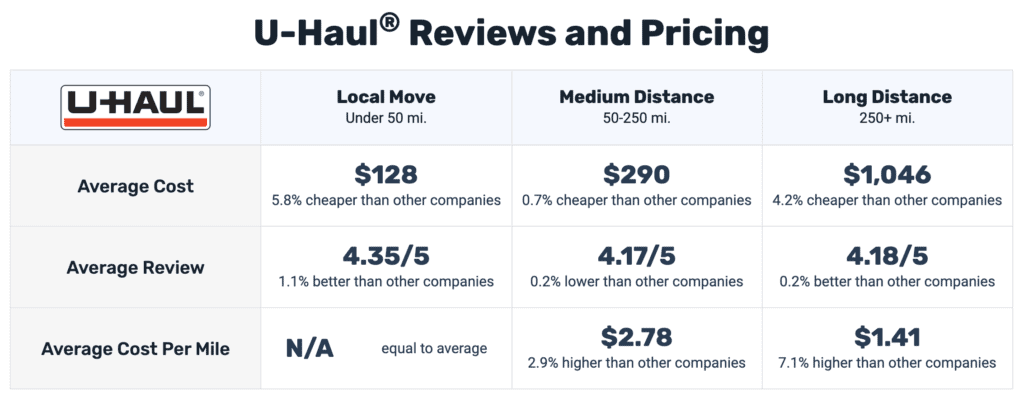
Can You Rent a U-Haul for More Than a Day?
Yes, you can (usually) extend your rental at the same daily rate if you need it longer than 24 hours (for a local move). All we had to do was call before the truck was due back and ask the store for an extension.
There’s also no limit to the number of days we could extend our rental. The only exception would be if our truck was already reserved by another customer for the days we wanted. It’s best to decide how many days you’ll need your rental at the time you make your original reservation. Otherwise, you may have to return your truck and get a new rental for the additional days you want.
“We went online and used a credit card to book a 10′ rental truck…and we thought the booking was all paid up. But it wasn’t — our card was just used to make the reservation.”
If you wanted to extend your rental to multiple days and there were no rental trucks available, U-Haul would likely sell you on one of their moving containers as an alternative, if those are available in your area.
For long-distance, one-way moves, a minimum number of days is included in the rental period, depending on the distance of your move. This might just be a single day for a shorter distance, like 150 miles or less. We asked, and yes, you can add days to your long-distance rental — but only by coordinating with your local U-Haul store in advance, and only as long as your truck is still available.
Beware! The following prepaid fees apply if you choose to extend a one-way rental:
- U-Haul trucks – $40 per day
- U-Haul trailers – $20 per day
- U-Haul towing devices – $20 per day
By the way, there are no discounts for returning the moving truck earlier than the minimum assigned number of days, but you can still return it earlier if you want. Virtually the only advantages would be that it reduces the likelihood of anything happening to the truck while in your care, and to get it off your to-do list.
Mileage, Fuel, and Other Add-On Costs
As you can gather, one of the biggest variables that affects your final U-Haul price is the mileage fee. Not to mention, your mileage will ultimately impact how much gas you need to pay for.
How Much Does U-Haul Charge for Mileage?
In general, the price per mile is region-specific and can also vary by season and time of the week. U-Haul mileage fees are also usually higher for local moves.
U-Haul Mileage Fees: Local Moving Truck Rental
The mileage fee quote we got for our local Florida move was $1.19/mile on a Tuesday. Setting the rental date to a Saturday instead increased that rate to $1.39/mile for all truck sizes.
To give you an idea of how U-Haul mileage fees vary based on region and day of the week, we requested some more quotes from U-Haul and found the following:
Los Angeles mileage rates (box trucks):
- Weekday quote: $1.09/mile on a Tuesday for all truck sizes
- Weekend quote: $1.39/mile on a Saturday for all truck sizes
Midwest (Columbus, OH) mileage rates (box trucks):
- Weekday quote: $0.99/mile on a Tuesday for all truck sizes
- Weekend quote: $1.19/mile on a Saturday for all truck sizes
U-Haul Mileage Fees: Local Pickup Truck or Cargo Van Rental
For our Florida move, the mileage rates for a U-Haul pick-up truck or cargo van were the same as for the box trucks, but that wasn’t the case in L.A. or Columbus. Here’s what we found:
Los Angeles mileage rates (cargo vans/pickup trucks):
- Weekday quote: $0.89/mile on a Tuesday
- Weekend quote: $0.99/mile on a Saturday
Midwest (Columbus, OH) mileage rates (cargo vans/pickup trucks):
- Weekday quote: $0.89/mile on a Tuesday
- Weekend quote: $1.09/mile on Saturday
Adding Up the Mileage:
In Florida, we drove our U-Haul truck all of eight miles from and back to the U-Haul store to take pictures. For this, we were charged $1.19/mile, for a total of $9.52.
You can probably start to imagine how much your mileage fee will stack if you drive your rental 20, 50, 100, or even more miles to and from the rental location.
How Do U-Haul Gas Fees Work?
Simply put, you will pay for any gas you use. You need to bring the truck back with at least as much gas as it started with.

And heed this warning straight from our receipt: “If returned with less than 1/4 tank, I agree to pay a $30.00 service fee.”
We spoke with a U-Haul rep who told us there’s no universal rule at U-Haul for this convenience fee, so this may be location-specific. In case you were wondering, U-Haul usually won’t reimburse you if you return the truck with more gas than you had to start with, so only get what’s needed at the gas pump.
Pro Tip: Here’s how to save money on your rental truck’s gas
How Much Mileage (MPG) Does a U-Haul Truck Get?
A 10′ U-Haul box truck can get up to 12 mpg, while the larger trucks can get up to 10 mpg — “up to” being the key phrase here. According to the website, these estimations are for ideal driving circumstances — which means once your truck is loaded down with boxes and furniture, the fuel efficiency will likely decrease.
The 15′ trucks and bigger are equipped with a fuel economy meter on the dashboard that shows you whether or not you’re getting the “Best MPG” in real-time. Our 10-footer had one too.
| Pro Tip: Sometimes a U-Haul rental will have a full tank of gas when you pick it up, and sometimes it won’t. Either way, you’re only required to replace the gas you use. We were given a truck with only 5/16 of a tank of gas, for instance.
If the U-Haul you’re renting from has gas pumps, ask for a full tank before you take it off the lot. And by full, we mean as full as possible. The fuel tank capacity for the 10′ truck is 31 gallons, according to the website. |
U-Haul Rental Rates: Long-Distance/One-Way Moves
What about when you’re renting your U-Haul for a long-distance or out-of-state move? In that case, rental pricing works a bit differently.
What Are the Mileage Rates for a Long-Distance/One-Way U-Haul Rental?
If you’re moving long-distance, a certain number of miles is accounted for and rolled into your final rate. There are technically no mileage limits, but if you exceed your mileage estimate, you’ll be charged $1.00/mile for the excess. Fortunately, this rate seems to be consistent for long-distance rentals regardless of location.
Remember, a one-way/long-distance rental simply means the truck is being returned to a different location than it was rented from. Technically, this could mean as near as one town over.
But while mileage is cheaper for long-distance moves, other fees are way, way more expensive, so if at all possible, make sure you stick to local (in-town) U-Haul rental rates, and return your truck to the location it came from.
Do U-Hauls Have Unlimited Miles?
With U-Haul, for both local and long-distance moves, there’s no limit to the number of miles you’re allowed to drive.
But remember, for local, in-town rentals, miles are never included in the advertised day rate — you’re charged per mile separately. For long-distance moves, you’ll be charged $1.00/mile for anything beyond the expected mileage that U-Haul determines is necessary for your move.
“…[W]hen it comes to some moving equipment, you can save money by renting instead of buying. U-Haul rents out furniture pads for $5 per half-dozen, as well as furniture dollies, appliance dollies, and utility dollies — for around $7 to $15 each”
If you do need to put on some extra miles, you’re better off looking at Penske or Budget. This is where the advertised $19.95 price really falls apart, unless you’re moving something a short distance.
U-Haul Trailers and Hitches: 101
We didn’t rent a trailer with our truck, but we got all the info straight from U-Haul.
Types of Trailers: What’s the Difference Between the Three Different U-Haul Trailers?
For smaller loads or something super fragile, U-Haul offers trailers that hitch to cars and trucks (depending on location availability). There are actually three different kinds of trailers you can typically rent.
Here are the three types of trailers U-Haul offers:
- Cargo trailers
- Utility trailers
- Vehicle trailers (Available only at some locations)
Here’s what you should know about each kind:
- Cargo trailers: As cargo trailers are enclosed, these are generally used for moving household items and furniture that you don’t want exposed to the elements. U-Haul likes to say they’re great for moving a dorm room.
- Utility trailers: These open trailers are ideal for transporting bulky or awkwardly shaped items that can withstand some exposure to the elements. You’ll often see them on the backs of pick-up trucks hauling landscaping equipment or construction waste.
- Auto transport/vehicle trailers: You can haul your car on U-Haul’s vehicle trailers, which come equipped with loading ramps, security chains, and multiple heavy-duty tie-downs. They also offer a tow dolly, which is a two-wheeler that lifts just the front wheels of the car off the ground. This can be a good choice for most front-wheel-drive and many rear-wheel-drive vehicles.
For local moves, U-Haul trailer rentals generally cost as little as $14.95 for the smallest options and as much as $34.95 for the largest ones (before taxes and fees). And obviously, unlike with U-Haul’s moving trucks, you don’t have to worry about a mileage fee because there’s no speedometer.
Option #1: U-Haul Cargo Trailers
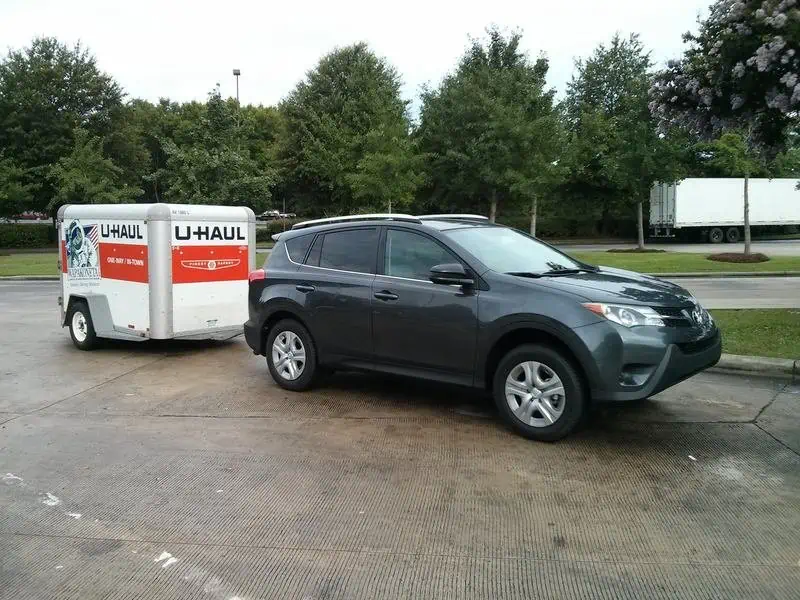
How exactly does renting a U-Haul cargo trailer work?
U-Haul cargo trailers officially come in three different sizes — 4′ x 8′, 5′ x 8′, and 6′ x 12′. And each one comes with a built-in, lockable latch to keep it secure.

Word of warning: Generally, none of the cargo trailers come built with the U-Haul “EZ Ramp,” so be prepared for some extra lifting, or consider hiring moving labor.
Like their trucks, U-Haul advertises its cargo trailers as being $14.95 (not including tax), and just like the trucks, that quote is for the smallest size trailer and only if you’re moving locally.
There’s no limit to the number of days you can keep a trailer, as long as availability permits. Depending on the distance of your move, a certain rental timeframe will be included in your estimate. A short, one-way move might just include a single day, while a cross-country move could include up to 11 days.
Several of U-Haul’s regular fees don’t apply to trailer rentals, such as mileage, refueling, environmental fee, and the vehicle license/cost recovery fee. However — and most importantly — trailer rentals do require a hitch installation fee if you don’t already have the proper hitch.
U-Haul Costs: Installing a Hitch
All types of U-Haul trailers require a proper hitch and lighting to hook to your vehicle.
You can use your own hitch if it’s compatible: a Class 2 or Class 3 with a 2-inch hitch ball.
If you don’t have a proper hitch — or you don’t have a clue what the above specs are talking about— you’ll probably have to have one installed. You can either get that done on your own or have U-Haul take care of it for an installation fee of around $100 or more. But take note — this is the fee to install and does NOT include the cost of the hitch itself! According to U-Haul’s website, the average cost for a trailer hitch is between $150 and $300 (not including installation).
Another note on hitches: If you’re thinking of buying a cheaper hitch elsewhere and bringing it to U-Haul to have them install it, think again. U-Haul won’t install third-party hitches.
We asked U-Haul how much it would cost to get one of our cars modded for towing a trailer, including parts and installation. We were quoted $469.09 online to mod my 2014 Kia Soul.
- Hitch: $149.95
- Hitch unlimited lifetime warranty: $5
- Ball mount: $24.95
- Hitch ball: $12.95
- Pin & clip: $2.95
- Wiring: $91.95
- Wiring service plan: $10
Subtotal: $297.75
- Installation: $132
- Tax: $39.34
Total for hitch and installation: $469.09
The U-Haul rep I spoke with about hitches told me that the cost of installation depends on the complexity of the work involved. Installation tends to be cheaper on older cars because the electrical wiring is simpler than with more expensive, newer cars.
We were actually quoted a slightly better price over the phone — $446.89 — so you may want to give U-Haul a call as well as run an online quote for the hitch, and pick the best price.
“…[T]he $19.95 only accounts for U-Haul’s lowest daily “rental truck fee.” While this price is consistent for local moves, U-Haul mileage fees and taxes can vary based on location, too.”
Either way, this isn’t exactly a deal, given that it doesn’t even include the rental truck. But at least you’ll be good to go for the future. U-Haul will provide you with all the pieces you need, but be prepared to get up-charged more than if you found it all elsewhere.
Also, let it be known that, technically, you can rent a trailer for your U-Haul truck rental — which already has a hitch — if you want to tow your car or if you need additional loading space.
How much does a U-Haul Cargo Trailer cost?
Local moves with a cargo trailer
Without any hitch installation and for single-day use, the smallest cargo trailer (4′ x 8′) with no ramp was quoted to us at exactly $14.95, before taxes or miscellaneous fees.
For their biggest cargo trailer (6′ x 12′), it was $29.95 under the same stipulations.
Long-distance moves with a cargo trailer
For a long-distance move, that quote gets significantly higher. Our quote from Tampa, Florida to Dallas, Texas (1,100 miles) for the smallest trailer (4′ x 8′), with no coverage, and up to five days with unlimited miles, came to $213 plus tax. And the largest cargo trailer (6′ x 12′) was $496 plus tax for the same route! If the local daily rates were applied to one-way rentals, those trips would cost about $75 and $150, respectively.
Don’t forget the hitch installation charges if you need it, which adds another several hundred, at minimum, depending on the year/make/model of your car.
Option #2: U-Haul Utility Trailers
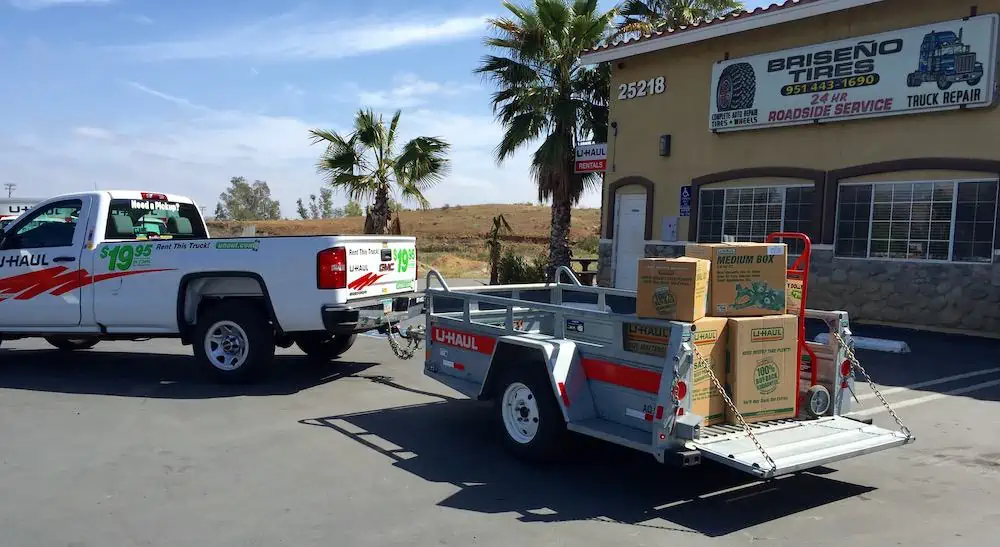
Utility trailers are needed when you have to transport something tall or oddly shaped. So when you move your arcade cabinet or (more likely) a refrigerator, you can strap it to this and haul it behind your vehicle.
You’ll need to bring your own ramp, though, because only the 5′ x 9′ and 6′ x 12′ utility trailers come with U-Haul’s fold-down “EZ-loading” ramps. And be careful when you book, there’s a 6′ x 12′ utility trailer without a ramp, too.
How Much Does a U-Haul Utility Trailer Cost?
Local moves with a utility trailer
For local moves, prices generally begin at $14.95 for the smallest utility trailer and go up to $34.95 for the largest option with a ramp. You can expect both larger and smaller utility trailers to scale roughly the same in cost as U-Haul cargo trailers.
Long-distance moves with a utility trailer
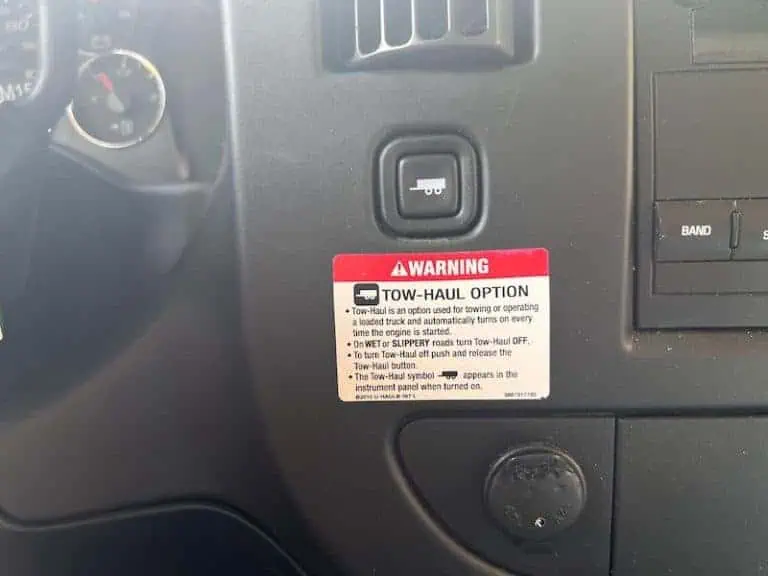
Option #3: U-Haul Vehicle Trailer
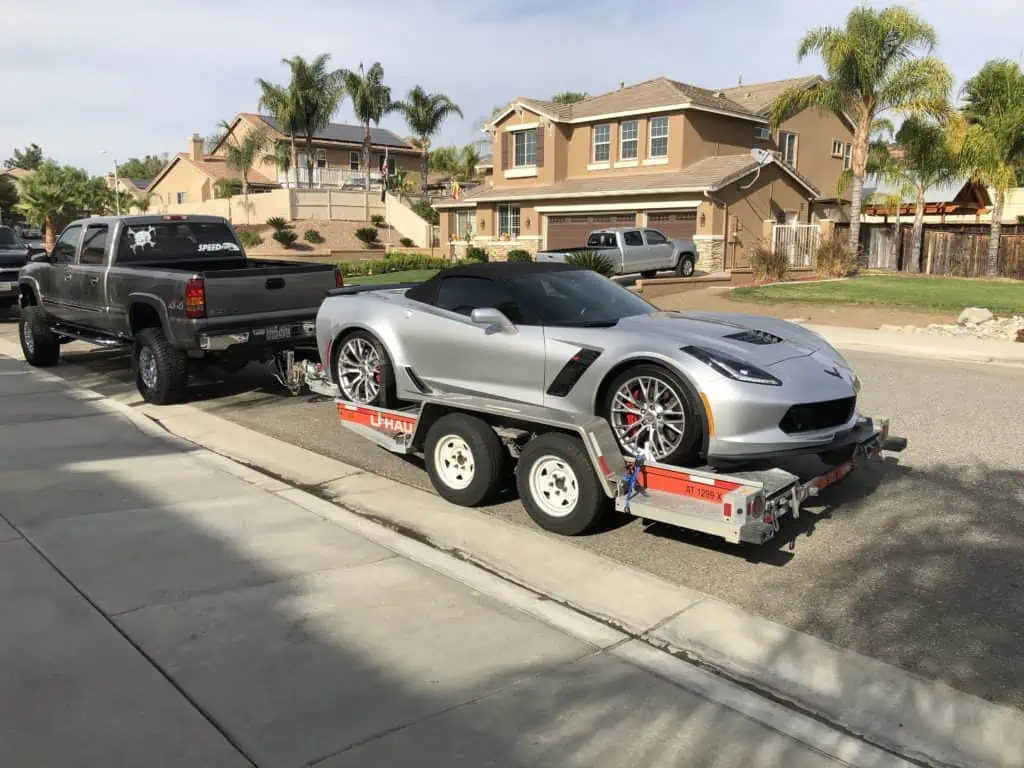
Finally, if you need to transport your vehicle and aren’t looking to ship it, check U-Haul’s car towing site, and maybe also call ahead to see if the U-Haul near you has any car and motorcycle trailers available.
This type of move can definitely save you some cash compared to normal car shipping, but keep in mind that do-it-yourself car transport is not for beginners and requires both a lot of time and some skill.
How Much Does a U-Haul Vehicle Trailer Cost?
Local moves with a vehicle trailer
For our local move, U-Haul rental rates for a tow dolly started at $44.95/day, and an auto transport trailer started at $54.95/day.
Long-distance moves with a vehicle trailer
To get an idea for a hypothetical long-distance move, we came prepared with two faraway ZIP Codes. Before taxes, our vehicle trailer cost for a move from Tampa, Florida to Dallas, Texas was quoted at $151 for a tow dolly and $301 for an auto transport trailer. Each quote included five days of use. We were told by the customer service rep that there’s usually a difference of about $100 between the tow dolly and auto transport rental fees, but apparently it can be even more than that!
“Some stores told us you have to pay U-Haul the exact moment you return the vehicle for any and all damages, while others told us it goes through insurance — so you should probably ask when you rent the truck what your location’s policies are.”
I was told my personal vehicle wasn’t heavy enough to tow our other car, so I would need to rent a U-Haul truck for that — an additional potential cost to keep in mind.
Please note that hitch installation, taxes, and other fees aren’t included in this quote, which, as you can see, is actually cheaper than the cost to buy and install a hitch.
The rep also told us U-Haul won’t let you rent any trailer of any kind if your vehicle doesn’t have a hardtop (e.g., convertibles and some SUVs and Jeeps). They also strongly recommend you not exceed 55 mph with any of this stuff attached to your vehicle.
U-Haul U-Box Containers
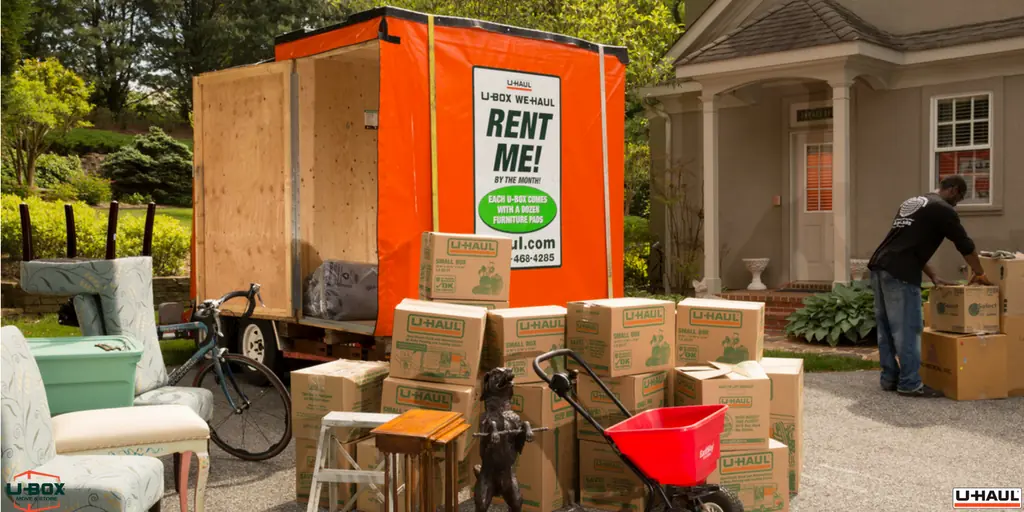
How Much Do U-Haul U-Box Containers Cost?
We also didn’t actually rent a storage container, but were told they are available for long-distance moves. The U-Box container comes in one size with a volume of 257 cubic feet. Each U-Box holds enough for about 1.5 rooms, so you order as many U-Boxes as needed to accommodate your move. Here was our long-distance U-Box quote without insurance coverage:
U-Box Container Quote from Tampa, FL to Dallas, TX:
- U-Box Container (includes one-month use): $99.95
- 2-dozen furniture pads: Free
- U-Box delivery in Tampa (for loading): $99.00
- Gentle ride shipping (guaranteed arrival date): $1,211.00
- U-Box delivery in Dallas: $99
- Subtotal (before taxes): $1,508.95
However, according to Moving101’s user-reported prices, the average price for a U-Box move is $3,074.
For a complete breakdown of all U-Box moving container costs before you make your U-Haul U-Box reservation, check out the Moving101 U-Box page.
U-Haul Insurance 101
What Are My U-Haul Insurance Options?
U-Haul has two main kinds of insurance. They’re called Safemove and Safemove Plus. Just like everything else, the added cost varies depending on whether your move is local or long-distance.
Keep in mind that there are exceptions, and Safemove Plus doesn’t cover “damage caused by improper packing, normal shifting of cargo in transit, or theft of cargo.“
Here’s a look at U-Haul’s two main coverage options:
Safemove
Safemove is essentially coverage for if someone hits your truck. It gives you:
- Damage waiver: Covers most accident damage to rental equipment, including tire damage and overhead
- Cargo protection: For damage or loss to cargo due to fire, collision, windstorm, or overturn of the rental truck
- Medical/life protection: For you and other passengers in the cab of your U-Haul rental truck
You’ll have to look to your own insurance if you hit someone else, or get Safemove Plus, which covers you against damage done to another vehicle. And your belongings inside the truck are only covered if you get hit, there’s a fire, a windstorm, or if your truck literally overturns.
Safemove Plus
Safemove Plus offers all the same coverage as Safemove, plus it also includes liability insurance (and has a $0 deductible):
- Supplemental liability coverage: This safeguards your personal insurance policy up to the first one million dollars of losses.
- No deductible: There’s a $0 deductible on ANY accidental damage claims for the U-Haul truck.
- All Safemove protection: Damage waiver, cargo protection, medical/life protection are included.
It’s also the only coverage that includes 100% overhead damage, like the kind you see on YouTube where people slam their trucks into low clearances.
And as a safeguard to your personal insurance, if you were to cause an accident or mess up their equipment somehow, this covers up to the first million dollars of losses.
For our simulated move, we went with U-Haul’s regular Safemove coverage for $15. Safemove Plus would have cost us $28.
Additional Coverage Options:
Safetow
Safetow is U-Haul’s coverage for trailers, tow dollies, and auto transports. The cost varies significantly depending on coverage levels and how far you’re driving. Here’s what it includes:
- Damage waiver: This covers damage to the U-Haul rental trailer or towing device.
- Towed property protection: There are multiple levels of protection to cover damage to your cargo or your vehicle while being transported with a U-Haul rental trailer, tow dolly, auto transport, or toy hauler. That is — unless you’re in Virginia. For some reason, automobiles aren’t covered by Safetow in Virginia.
- Medical/life protection: In case of an accident (subject to exclusions), this coverage provides you with some degree of medical and life protection. Your passengers are only protected by this coverage while they’re riding in the passenger area of the towing vehicle.
Safetrip
U-Haul also offers Safetrip supplemental roadside protection for an extra $5 per local rental or $7 per one-way rental. Safetrip comes in handy if you need a jump start or fuel service, get stuck in snow, lose your keys, or have trouble with your trailer hook-up. Hopefully, none of these things would happen during your move, but Safetrip is an option if you’re worried about it.
Safestor
Safestor protects your things while they’re being stored in a U-Box container or self-storage unit. It covers loss or damage caused by major perils such as fire, hurricane, vandalism, burglary, earthquake, flood, and more.
Safehaul
Safehaul covers your items while they’re in transit within a U-Box container, in case they become damaged along the way.
Do I Have To Buy Insurance With My U-Haul?
No, you don’t have to buy insurance of any kind to rent a U-Haul.
But should you?
Here’s the thing: While you’re statistically in the clear, U-Haul’s policies are perfectly crafted to leave you on the hook if absolutely anything were to go wrong.
- Your personal auto insurance policy most likely does not cover damages to rental trucks.
- Your credit card likely does not cover any damages to rental trucks.
- You’re responsible for damages, even if it’s not your fault, including things like vandalism.
- Some stores told us you have to pay U-Haul the exact moment you return the vehicle for any and all damages, while others told us it goes through insurance — so you should probably ask when you rent the truck what your location’s policies are.
Keep in mind that U-Haul only offers Safemove Plus for their box trucks. When you rent a pick-up truck or cargo van, your only option is Safemove.
U-Haul Equipment
We didn’t rent any equipment or buy any boxes or supplies, but we definitely had the option!

Here’s how much the stuff would’ve cost us had we opted to buy supplies from U-Haul
U-Haul Moving Equipment Online Purchase Prices:
- Padlock: $4.95 to $16.95 (best value is a 4-pack for $10.50) unless you want to get really fancy with a $49.95 braided steel cable lock
- Stretch plastic wrap: $10.95–$29.25
- Boxes: $1.30–$2.34 per box for small, medium, and large boxes (They offer tons of specialty boxes, too, and you’ll pay a lot more them — like $144.95 for a bike box.)
- Tie down rope: $3.95
- Moving straps: $24.95
- 2-rolls of packing tape & dispenser: $8.99
- Furniture dolly: $19.95
Speaking of which, when it comes to some moving equipment, you can save money by renting instead of buying. U-Haul rents out furniture pads for $5 per half-dozen, as well as furniture dollies, appliance dollies, and utility dollies — for around $7 to $15 each, depending on whether your move is local or one-way.
*These prices came from U-Haul’s website and may vary by location. You may want to check your local store first before buying online in case their prices are cheaper.
How Much Does Moving Labor Cost?
When you go to a U-Haul shop, it’s likely they’ll try and sell you on movers. Even the inside of their trucks have advertisements for moving labor all over them.
How much are U-Haul movers? Mover prices will vary dramatically, depending on the number of hours booked, how many movers you book, whether they are loading, unloading, or both, and how soon you need them.
U-Haul’s base rate is for two helpers with a two-hour minimum per location (either your starting point or end point). But if both locations are near each other, you may be able to combine the loading and unloading at both locations into one two-hour block.
The U-Haul moving labor quotes we were provided averaged about $245 each, with most between $200 and $300, and one for $600! Such wild differences are exactly why you should get your own moving labor quotes to compare against theirs.
“If the U-Haul you’re renting from has gas pumps, ask for a full tank before you take it off the lot. And by full, we mean as full as possible. The fuel tank capacity for the 10′ truck is 31 gallons, according to the website.”
The way U-Haul’s movers work is that they have a network of local movers that sign up to receive job requests via their marketplace.
But unlike HireAHelper’s $1,000 guarantee, if anything goes wrong or gets broken during a move with U-Haul, you’re mostly taking your chances. They’ll connect you with movers, but it’s between you and them after that.
We found this part of their terms, too:
“Furthermore, the Moving Help request and its acceptance and if applicable, any resulting provision of Services, are solely between You and the Moving Help®. Therefore, when and where there are any claims, demands, liabilities, damages or losses incurred as a result of the same, You, your heirs, successors and assigns, do hereby waive and release Us (Our officers, directors, agents, parent, subsidiaries, affiliated companies and employees) from any such claims, demands, liabilities, damages or losses.
You acknowledge and agree that both You and the Moving Help® each have the right to pursue a claim against one another in a Court of competent jurisdiction or in another similar forum of dispute resolution.”
This is compared to movers through HireAHelper, which provides some insurance for free (and that $1,000 service guarantee if anything goes wrong), plus additional insurance starting at $12.
Are Movers Actually Worth It?
The difference between a move that takes you all day, breaks your back, and keeps your stuff out of the hands of amateurs could be as little as $200, depending on how much stuff you have. Movers may be the most value you can get from any single add-on.
Other Things To Know About Your U-Haul Quote
What Actually Happens at the U-Haul Store After You Reserve Online or Over the Phone?
We went online and used a credit card to book a 10′ rental truck, and we thought the booking was all paid up. But it wasn’t — our card was just used to make the reservation.
While our vehicle was reserved online, we had to reproduce the same or another form of payment in person (cash was acceptable as well), regardless of what we used online to reserve it. Makes sense, but might be a stumbling block for some people.
After that, U-Haul put a hold on our bank account upfront for all the estimated costs (i.e., rental fee, environmental fee, tax, and mileage). They asked us how many miles we thought we’d drive for our local move and added that to the total cost for the hold. If you end up driving less, they’ll charge you less in the end. If you end up driving more, they’ll charge more. Plus, they’ll add any applicable miscellaneous fees.
When we returned with the vehicle, they checked out the truck before charging us to verify gas level and mileage (and probably to check for damage). We were given a paper receipt with the total costs. Because we used a debit card already on file, no further action was needed.
Paying for a U-Haul in Cash?
We were told that customers paying in cash for a local rental need to put down a $100 deposit, or the estimated rental charges, whichever is greater. This would eventually be reimbursed, minus our total cost, upon return of the vehicle.
Here’s what to expect if you’re paying in cash, straight from their website:
“If you’re paying with cash, the following is due when you pick up your equipment:*
- In-Town truck – $100 or estimated rental charges (whichever is greater)
- One-Way truck – $100 plus rental rate
A major credit card or debit card with a major credit card logo is required at time of pick up for all Cargo Van and Pickup Truck rentals.
The total estimated charges for your rental are due when you pick up your equipment regardless of your method of payment. Payment can be made by credit card, debit card or cash.
Cash is accepted for pickup and van rentals. However, a valid credit or debit card with a major credit card logo will also need to be presented in the name of the renter.”
U-Haul Discounts
There are no formal military, senior, or student discounts at U-Haul. It’s really just up to the discretion of the U-Haul store you’re renting from if they give you a deal or not. The rep told us that a discount anywhere between 10% and 15% is what they’re allowed to apply to an order if they’re so inclined.
How Old Do You Have To Be To Rent a U-Haul?
Wanting to test the age limits, we sent one of our 20-year-old team members to officially do the honors of picking up the vehicle. It didn’t matter, as U-Haul says you just need to have a valid driver’s license and be at least 18 years old to rent a truck and 16 years old to rent a trailer.
Real U-Haul Rental Costs We Paid
Our final cost for our U-Haul rental was $53.79. Without skimping on coverage completely, it’s the cheapest we could get it.
- Rental fee: $19.95
- Mileage charge: $9.52
- Safemove damage coverage: $15.00
- Environmental fee: $1.00
- Vehicle license/cost recovery fee: $1.20
- 1.6 gallons of gas: $4.99
- Tax on rental: $2.13
Total: $53.79
We got a 10′ truck, U-Haul’s smallest with no ramp, and drove it eight miles. We bought the cheapest insurance, absolutely zero equipment and zero labor, and got hit with no other fees.
Our bill was still almost three times the advertised price.
Of course, $53.79 isn’t a bad deal, depending on what you need it for. The problem is that if you only need a quick lift to pick something up, $50+ can render a lot of good deals useless.
On the other hand, if you were seriously moving, odds are great you’d drive many more miles, and your fuel usage would probably be way higher, given you wouldn’t be hauling air. And if it’s during the busy moving season, the mileage rates will likely be higher too, with it all adding up to quite a bit more than $19.95.
The Bottom Line
Nobody pays $19.95 plus tax on a U-Haul rental.
An extremely conservative estimate for a very small, local move is probably closer to around $125 for the rental. You’ll realistically need one of the larger trucks for a real move.
And that’s strictly local. For long-distance moves, even a small load will be much closer to $1,000 or more. And that’s assuming you don’t need a hitch installed.
How much you finally shell out will depend on your circumstances, your preferences, and your requirements. Keep the above in mind as you plan out your move. You’ll probably save at least enough for some extra coffee on the drive to your new home!



